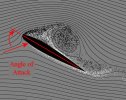yes if a drone is being pulled down due to a great weight the airflow will be different and blades will stall.
Okay, so we're agreed on that?
But the craft has already lost lift way before the stall issue.
If weight is greater than lift, then we get no flight
My previous responses in this discussion were aimed at the guy who believed "stall" refers only to when the engine quits. Subsequent replies were in response to other suggestions that fixed-pitch propellers on quadcopters cannot "stall".
I tried to point out obvious examples where the prop blades could be made to suffer aerodynamic stall, the clearest extremes being if the motors stop turning, or the drone is strapped to too heavy a payload. But obviously there is wide range of performance between the drone operating under ideal conditions versus motors stopped or too heavily overloaded.
The point I was trying to make was that somewhere between those good vs bad extreme endpoints, the props will reach a load point where the airflow transitions from smooth laminar flow to turbulent stalled airflow. And that point can be reached even without the motors stopping or without strapping a cement block to the drone.
DJI
Avata yaw stall. DJI Phantom vortex ring state. High-performance racing quads put into a too sudden high-g manoeuvre. In each of those cases, even though the fixed-pitch props are still spinning on the same fixed-pitch axis relative to their motors, what matters is that the direction of the airflow is coming at the propeller blade at too high an angle of attack causing the blade to stall.
I understand aerodynamics, thanks. I teach it for a living. [...]
You have quite a few misconceptions amongst your examples and thoughts on lift, thrust, drag and weight.
If I'm wrong in anything I wrote,
please point it out and correct me. I'm always happy to learn stuff, and I'm not afraid to admit it when I'm mistaken in my beliefs. I much prefer to be corrected as soon as possible if it prevents me from continuing to spout nonsense that only embarrasses me later. For example, in this
other post recently talking about VPS optical sensor vs GPS sensor, I posted a new video experiment determined to prove someone else wrong, only to discover in shock that it was me who's been wrong all along.












